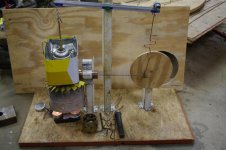doug8cat
Titanium
- Joined
- Jul 10, 2008
- Location
- Philadelphia
As the title indicates, my niece who is ten and has already been moved to the advanced placement program in science which she loves. I thought a nice gift for her (and project for me) would be a small Stirling engine.
I work with 99% cast iron at the shop and the only scrap brass there are beater bars.
Reading up on the different alloys available got me a bit confused as to which on would work best, machine well and be nice looking when polished up and mounted on a wood base.
So I ask if anyone has built a Stirling what alloy did you use and with what results.
I figured for the first one; prototype I'd us what I could get and see how it goes.
If anyone has some scarp round: ~1" to 1.5" in dia., length 1.5" to 3" plus and flat stock 0.25 to 0.385, square inch and above. I will of course compensate for postage and "scrap fee"
I love to see kids taking an early interest in science, any academics at all really these days. I just remember when I got my first old used RCA oscilloscope in the early 80's. It lead me to teach myself electronics, then an undergraduate in biology, followed by a masters in neuro-pharmacology and best part of a doctorate in the same field. Okay how did he end up in machining? "...What a long strange trip its been..." story for another time.
Thanks everyone any help will be greatly appreciated;
Alex might even want to be a machinist! She's quiet the smart cookie, got to AP cause she was bored in the regular class and took to annoying the teach to pass the time.. just like her uncle
Doug
I work with 99% cast iron at the shop and the only scrap brass there are beater bars.
Reading up on the different alloys available got me a bit confused as to which on would work best, machine well and be nice looking when polished up and mounted on a wood base.
So I ask if anyone has built a Stirling what alloy did you use and with what results.
I figured for the first one; prototype I'd us what I could get and see how it goes.
If anyone has some scarp round: ~1" to 1.5" in dia., length 1.5" to 3" plus and flat stock 0.25 to 0.385, square inch and above. I will of course compensate for postage and "scrap fee"
I love to see kids taking an early interest in science, any academics at all really these days. I just remember when I got my first old used RCA oscilloscope in the early 80's. It lead me to teach myself electronics, then an undergraduate in biology, followed by a masters in neuro-pharmacology and best part of a doctorate in the same field. Okay how did he end up in machining? "...What a long strange trip its been..." story for another time.
Thanks everyone any help will be greatly appreciated;
Alex might even want to be a machinist! She's quiet the smart cookie, got to AP cause she was bored in the regular class and took to annoying the teach to pass the time.. just like her uncle

Doug



 Thats a good thing!!
Thats a good thing!!


